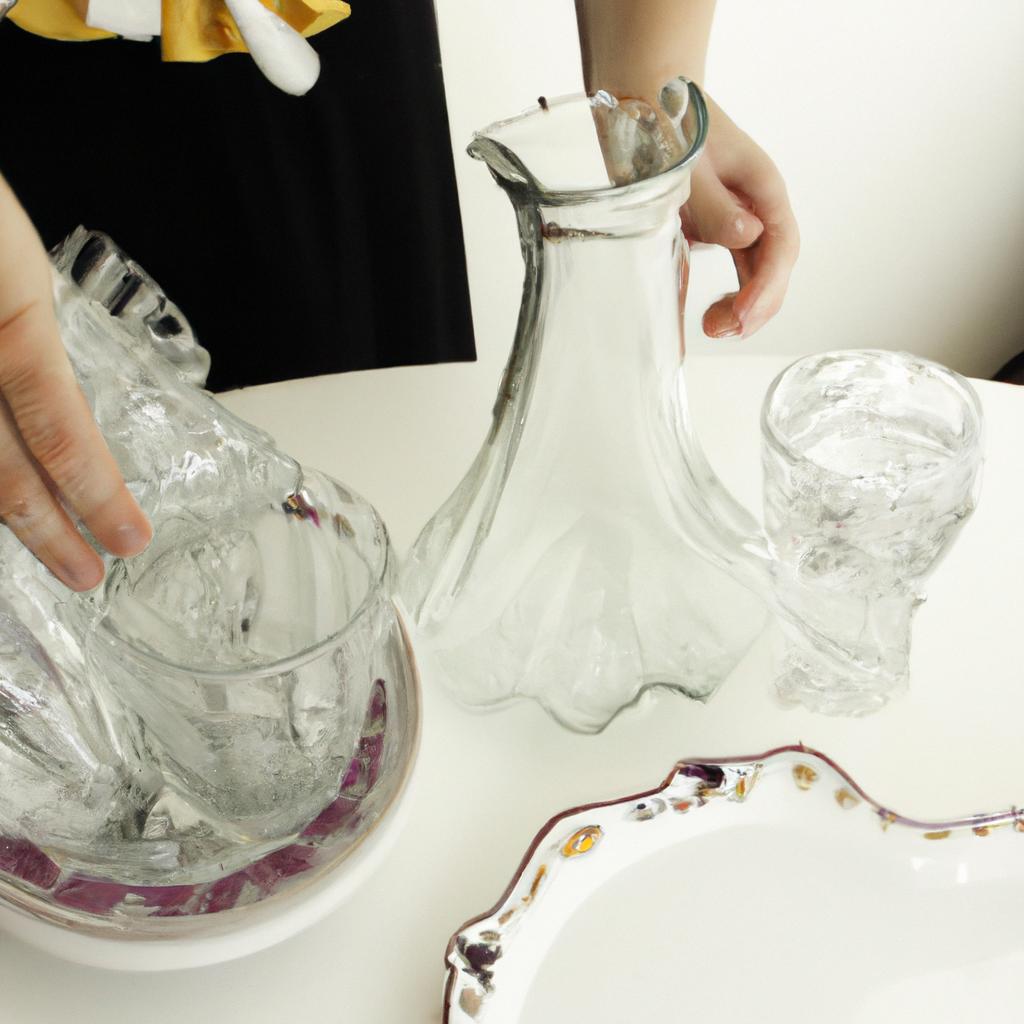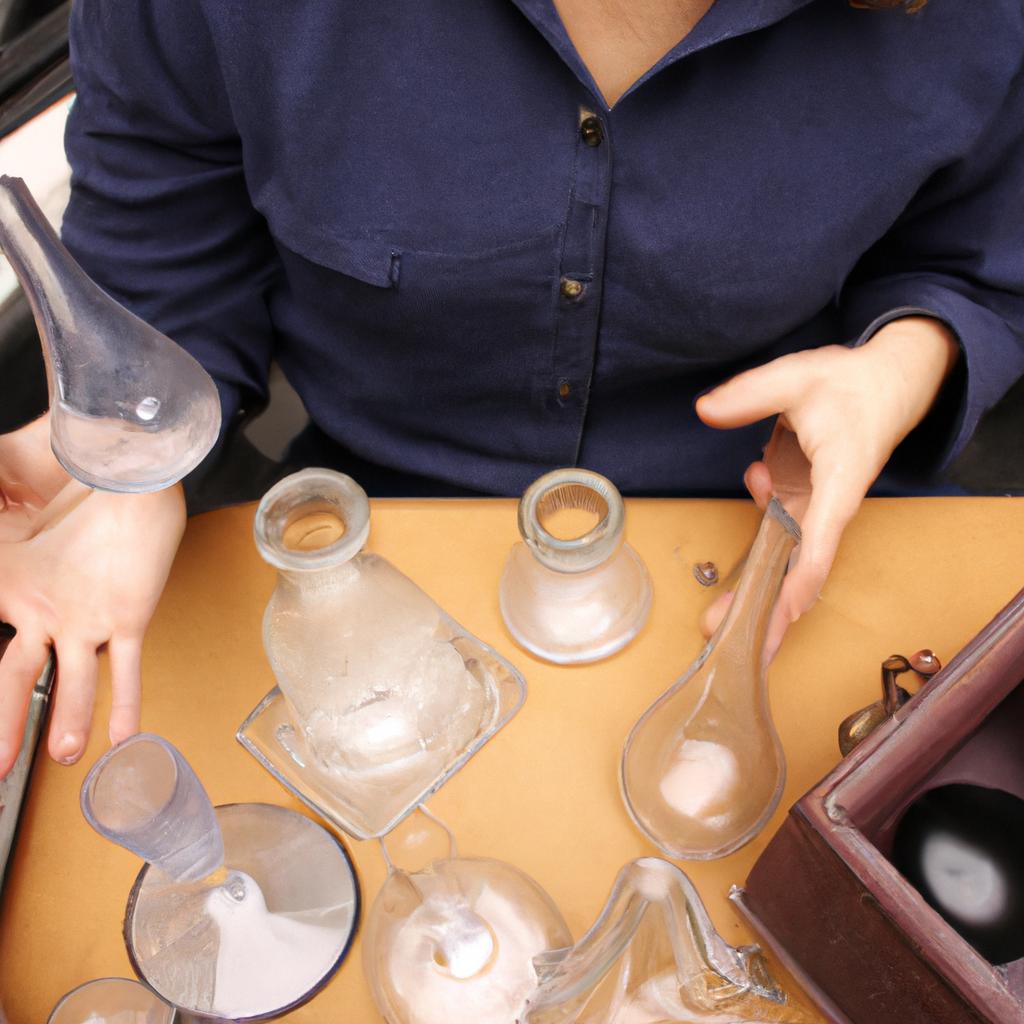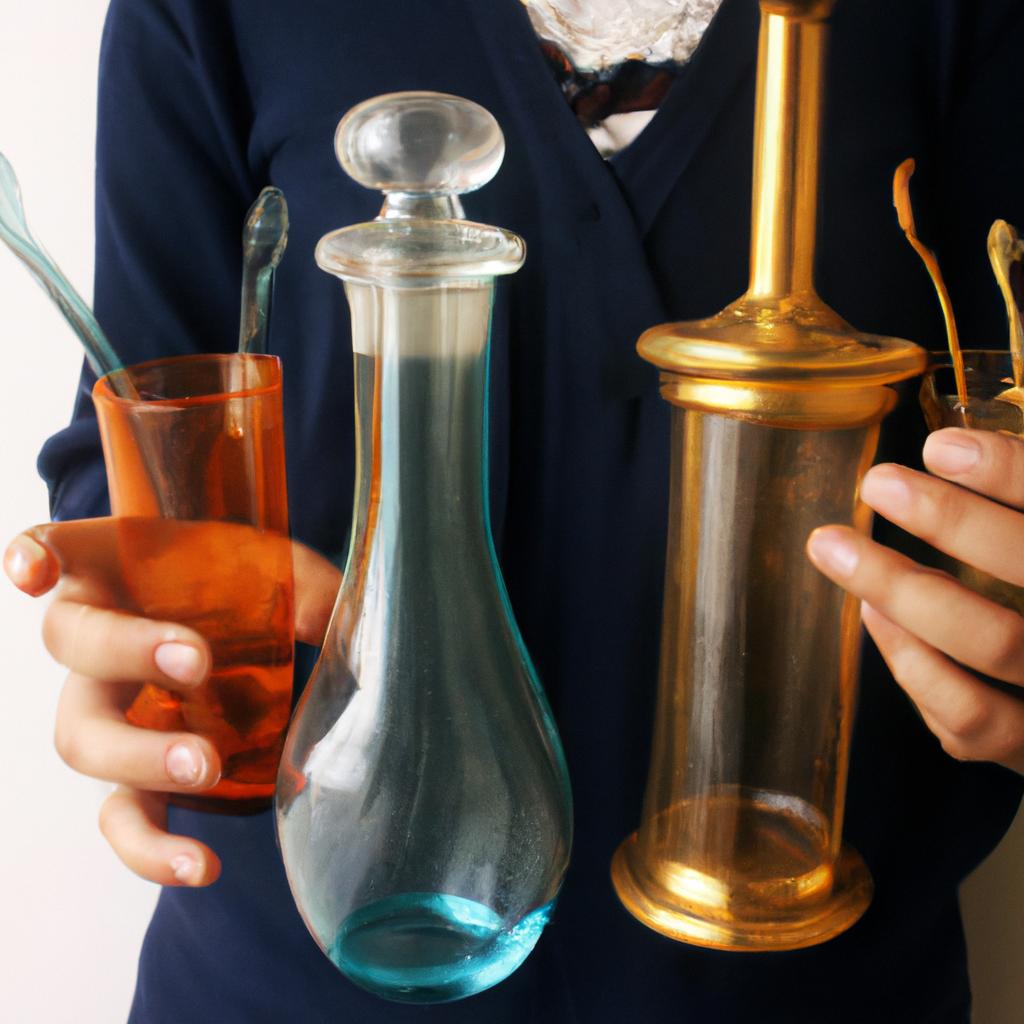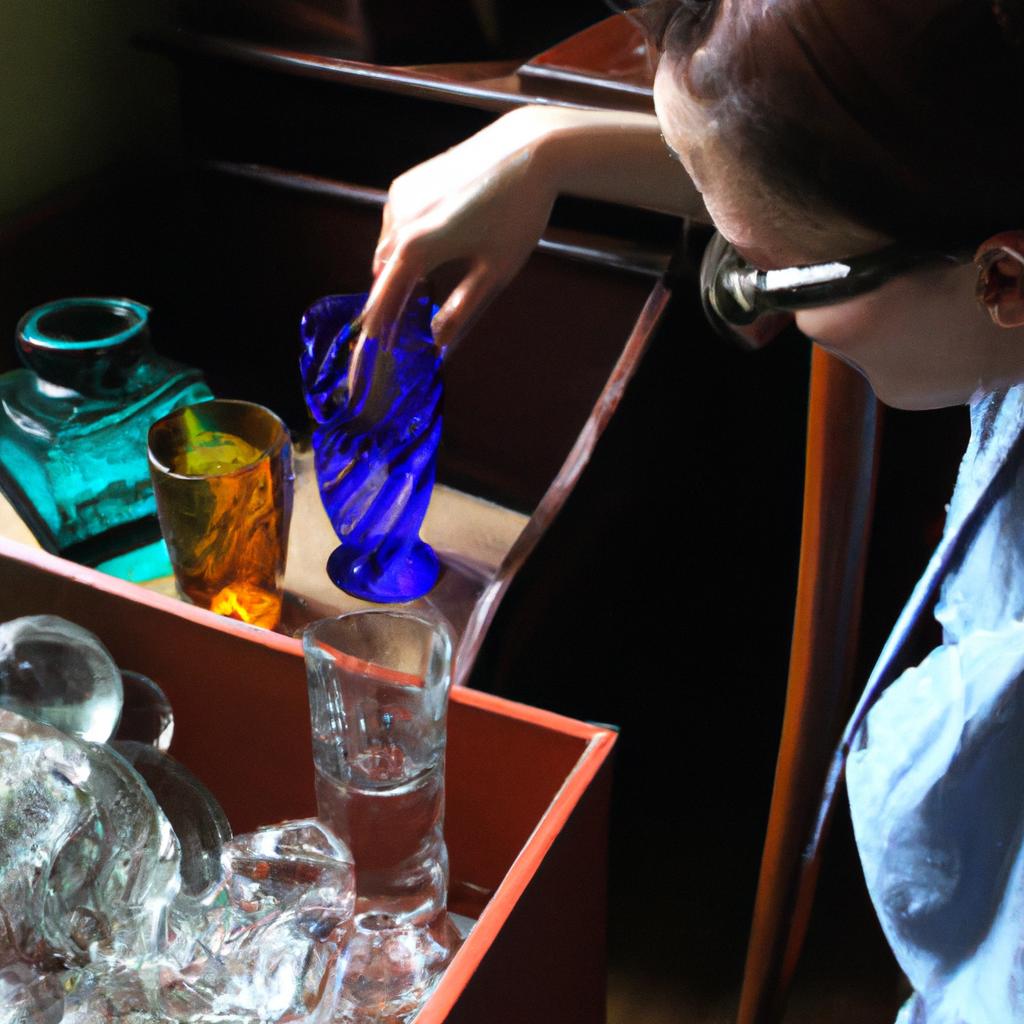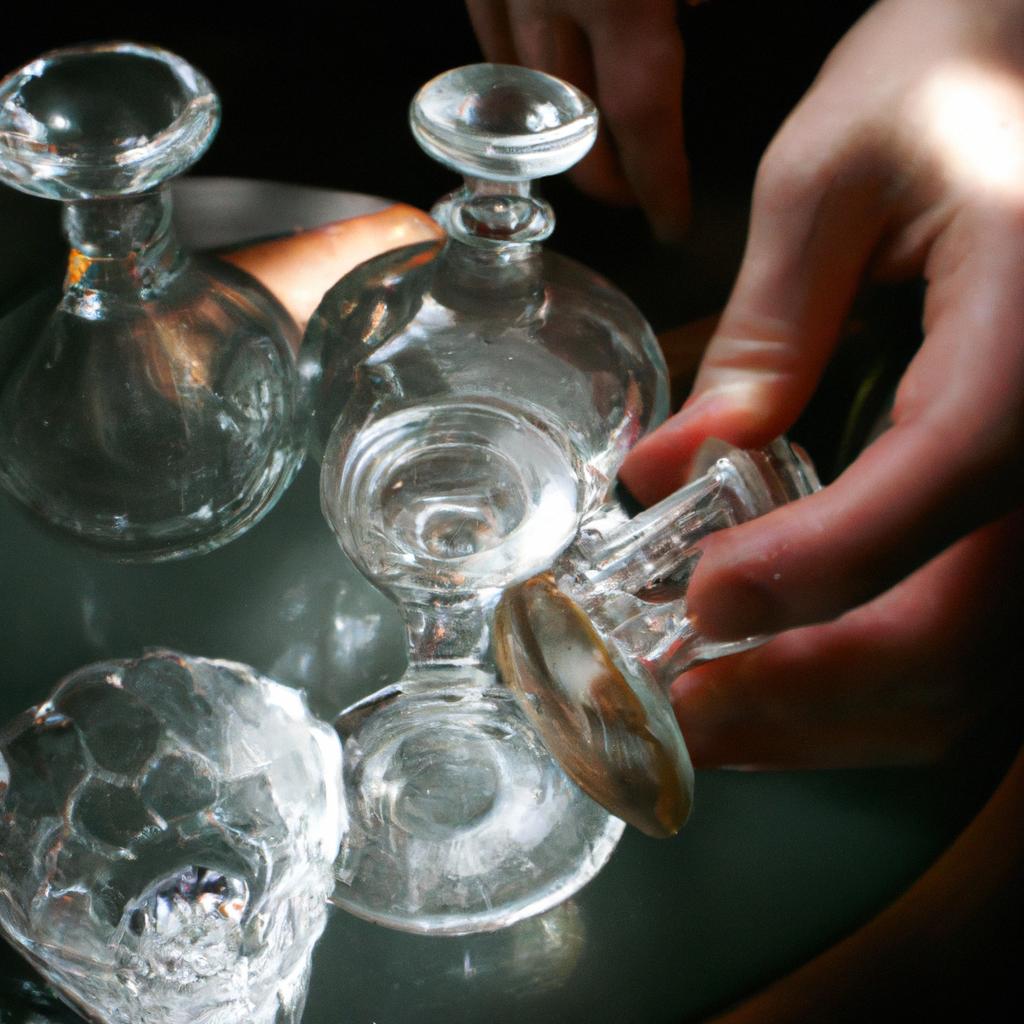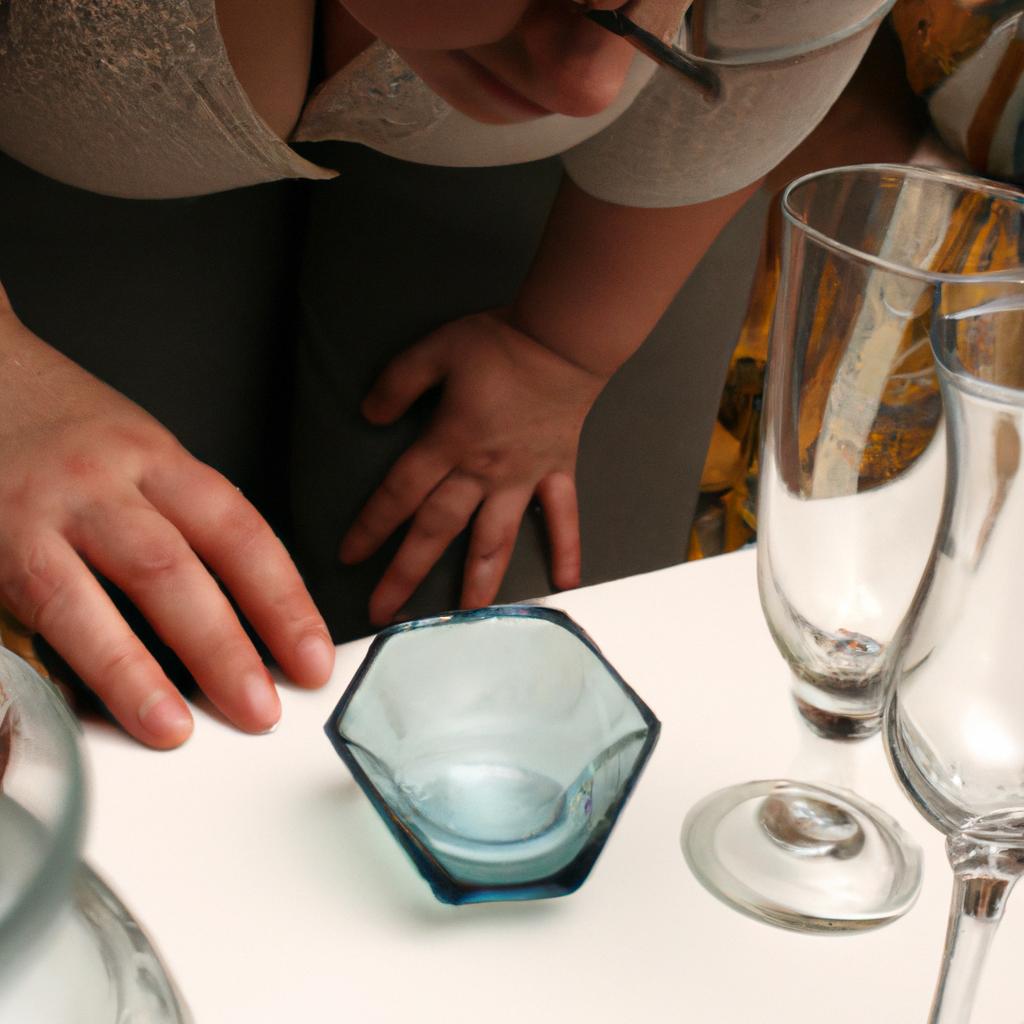Popular Vintage Glassware: Antiques and Collectibles
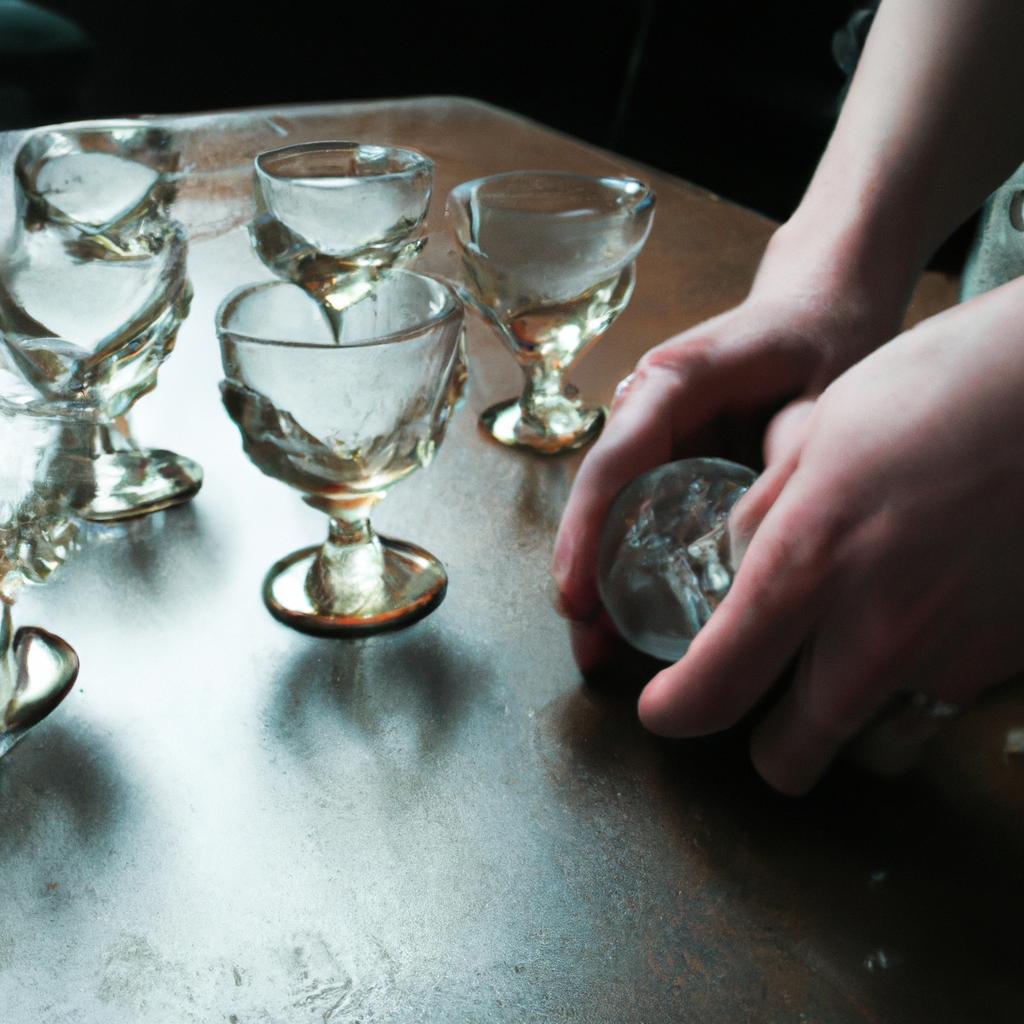
Glassware has long been a coveted item among collectors and antique enthusiasts alike. The allure of vintage glassware lies in its intricate designs, craftsmanship, and historical significance. From delicate crystal stemware to colorful Depression-era glass, these treasures from the past offer a glimpse into bygone eras and provide a tangible connection to our collective history.
One such example of popular vintage glassware is the Fenton Hobnail milk glass collection. Produced by the Fenton Art Glass Company during the mid-20th century, this series of milk glass pieces quickly gained popularity for their distinctive hobnail pattern. With its raised bumps adorning each piece, the Fenton Hobnail collection exemplifies both elegance and charm. The meticulous craftsmanship involved in creating these remarkable objects makes them highly sought after by collectors around the world.
Vintage glassware not only holds aesthetic appeal but also serves as a window into cultural and societal trends of different time periods. By examining the evolution of glassmaking techniques and styles, we can gain insights into the changing tastes and preferences throughout history. Furthermore, exploring the stories behind each unique piece allows us to appreciate the artistry involved in their creation while unraveling narratives that have shaped our society’s material culture. In this article, we In this article, we will delve deeper into the Fenton Hobnail milk glass collection and explore its history, characteristics, and value in today’s market. We will also discuss some tips for identifying authentic pieces and caring for vintage glassware to ensure their preservation for years to come. Whether you are a seasoned collector or simply have an interest in the beauty of vintage glassware, this article aims to provide you with valuable information and insights into the world of Fenton Hobnail milk glass and its significance in the realm of antique collecting.
Types of Vintage Glassware
Imagine walking into a vintage store and stumbling upon a stunning crystal vase from the 1920s. Its intricate design, timeless elegance, and historical significance instantly captivate your attention. This case study highlights the allure of vintage glassware – an enchanting realm that encompasses various types of glass objects with rich histories and artistic appeal.
Vintage glassware can be classified into several distinct categories, each with its own unique characteristics and charm. The first category is pressed glass, which gained popularity in the late 19th century as an affordable alternative to hand-blown glass. Pressed glass involves shaping molten glass using molds, resulting in intricately designed pieces such as decorative plates, bowls, and vases. These items often feature delicate patterns or motifs that evoke nostalgia for bygone eras.
Another type of vintage glassware is carnival glass, known for its vibrant colors and iridescent finish. Developed in the early 20th century, carnival glass was initially produced as inexpensive prizes at carnivals hence its name. Today, it is highly sought after by collectors due to its dazzling array of hues like amethyst purple, cobalt blue, and emerald green. Carnival glass items range from decorative bowls to whimsical figurines and are cherished for their distinctive play of light.
Art Deco glass represents yet another captivating genre within vintage glassware. Emerging during the interwar period (1918-1939), Art Deco brought forth bold geometric shapes and streamlined designs inspired by modernism. Artists experimented with new techniques such as acid etching and enameling to create visually striking pieces like cocktail shakers, perfume bottles, and table lamps. Art Deco glass embodies the spirit of sophistication and glamour synonymous with this iconic era.
To further understand the wide-ranging appeal of vintage glassware, consider these emotional responses evoked by specific attributes:
- Nostalgia: Owning a piece of vintage glassware can transport us back in time, evoking memories of cherished moments and a sense of connection to the past.
- Aesthetic pleasure: The intricate designs, vibrant colors, and elegant forms of vintage glassware can bring joy and beauty into our lives.
- Artistic appreciation: Vintage glass objects often showcase exquisite craftsmanship and artistic techniques that make them true works of art.
- Collecting passion: For many enthusiasts, collecting vintage glassware is not only about owning beautiful items but also about preserving history, discovering unique pieces, and engaging with a passionate community.
To summarize, vintage glassware encompasses various types including pressed glass, carnival glass, and Art Deco glass. Each category showcases distinct characteristics and holds its own allure for collectors and enthusiasts alike. Now we will explore the factors influencing the value of these captivating artifacts.
Factors Affecting the Value of Vintage Glassware
Glassware from the past holds a certain allure, with its intricate designs and nostalgic charm. In this section, we will explore some popular types of vintage glassware that have captivated collectors and enthusiasts alike.
One such type is Depression glass, which gained popularity during the Great Depression in the 1930s. This translucent colored glass was often given away as promotional items or sold at low prices. Its bright hues and delicate patterns evoke a sense of hope amidst difficult times. A case study of a pink Depression glass bowl, known for its iconic “Cherry Blossom” pattern, exemplifies how these pieces can add beauty to any collection.
To further understand the diverse world of vintage glassware, let us delve into four distinct categories:
-
Art Deco Glass: Characterized by geometric shapes and bold colors, Art Deco glassware reflects the glamour and opulence of the roaring twenties. From sleek vases to avant-garde cocktail shakers, these pieces exude an air of sophistication.
-
Mid-Century Modern Glass: As mid-century design embraced clean lines and simplicity, glassware followed suit. Iconic pieces like Scandinavian-inspired vases and elegant barware showcase the functionality and elegance synonymous with this era.
-
Carnival Glass: Known for its iridescent surface and vibrant hues, carnival glass has long been cherished by collectors worldwide. Originally produced as affordable alternatives to more expensive art glass, these pieces now hold their own intrinsic value.
-
Milk Glass: With its milky white appearance resembling porcelain or marble, milk glass possesses timeless appeal. Often adorned with intricate details such as lace-like edges or embossed motifs, it adds a touch of elegance to any display.
Now let’s take a closer look at some factors affecting the value of vintage glassware in our next section – Factors Affecting the Value of Vintage Glassware. Understanding these aspects will enable you to make informed decisions when adding to your collection or valuing existing pieces.
Tips for Identifying Authentic Vintage Glassware
When it comes to determining the value of vintage glassware, there are several factors that collectors and enthusiasts take into consideration. Understanding these factors can help you make informed decisions when buying or selling antique glass items. Let’s delve into some key aspects that affect the value of vintage glassware.
One factor that greatly influences the value of vintage glassware is its rarity. The scarcity of a particular piece can significantly drive up its price in the market. For example, let’s consider a hypothetical case study: an exquisite hand-blown Art Deco vase from the 1920s produced by a renowned glassmaker. Due to limited production numbers and time passing since its creation, this vase becomes increasingly rare over the years. As a result, collectors seeking such unique pieces would be willing to pay a premium for it.
Another factor that affects the value is the condition of the vintage glassware. Items in pristine condition with no signs of damage or wear tend to command higher prices than those with visible flaws or repairs. Collectors often seek out pieces that have been well-maintained, as they retain their original beauty and integrity. A small chip or crack on an otherwise valuable item could decrease its worth significantly.
The historical significance and provenance of vintage glassware also play a crucial role in determining its value. If an item has ties to significant events or individuals from history, it may attract greater attention and demand among collectors. For instance, owning a champagne flute used during a royal wedding ceremony adds immense historical appeal to an already valuable piece of glassware.
To summarize, here are four important factors affecting the value of vintage glassware:
- Rarity: Limited availability increases desirability.
- Condition: Pristine items tend to fetch higher prices.
- Historical Significance: Ties to notable events enhance value.
- Provenance: Traceable ownership history adds authenticity.
By considering these factors, collectors and enthusiasts can better understand the value of vintage glassware in their possession or when considering new additions to their collections.
TABLE: Examples of Vintage Glassware Values
| Item | Rarity Level | Condition | Historical Significance | Provenance |
|---|---|---|---|---|
| Art Deco Vase | High | Excellent | Moderate | Unknown |
| Depression Glass | Medium | Good | Low | Family heirloom with documentation |
| Carnival Glass | High | Fair | Low | Acquired from a reputable auction house |
| Milk Glass Bowl | Low | Poor | None | Garage sale find without any known history |
Now that we have explored the various factors affecting the value of vintage glassware, let’s delve into another exciting aspect of this hobby – collecting.
Collecting Vintage Glassware: Where to Start
Transitioning from the previous section about identifying authentic vintage glassware, let’s delve into understanding the value that these antiques and collectibles hold. To illustrate this, consider an example where a rare 19th-century pressed glass pitcher was discovered in an old attic. This pitcher, with its intricate design and historical significance, captures the essence of what makes vintage glassware so sought after.
When evaluating the value of vintage glassware, several factors come into play. It is essential to assess these elements carefully before making any purchase or determining the worth of your own collection. Here are some key points to consider:
- Rarity: The scarcity of a particular piece greatly impacts its value in the market. Items produced in limited quantities or those associated with well-known artisans tend to command higher prices.
- Condition: The condition of vintage glassware can significantly affect its desirability and price. Pieces without chips, cracks, or excessive wear tend to be more valuable than those with visible damage.
- Historical Significance: Any glassware that holds historical importance due to its association with a specific time period or event often garners increased interest among collectors.
- Aesthetic Appeal: The visual appeal of vintage glassware plays a crucial role in determining its value. Pieces featuring unique colors, patterns, or innovative designs may be highly coveted by enthusiasts.
To better understand how different aspects contribute to the value of vintage glassware, refer to the following table:
| Factor | Impact on Value |
|---|---|
| Rarity | High |
| Condition | Medium |
| Historical | Medium-High |
| Significance | |
| Aesthetic Appeal | High |
As you can see from this table, rarity and aesthetic appeal have a significant impact on value compared to other factors such as condition and historical significance.
In conclusion, comprehending the value of vintage glassware involves considering various aspects like rarity, condition, historical significance, and aesthetic appeal. These factors collectively contribute to the allure that surrounds these timeless pieces. As we move forward, let us explore how to care for and display vintage glassware with utmost dedication and finesse.
Caring for and Displaying Vintage Glassware
Glass has been a popular material for creating household items for centuries. From delicate drinking glasses to ornate vases, vintage glassware holds a special place in the world of antiques and collectibles. By studying its history, collectors gain valuable insights into the craftsmanship and artistry that went into producing these timeless pieces.
Consider the case of Sarah, an avid antique collector who stumbled upon a stunning Art Deco glass vase at a local thrift store. Intrigued by its unique design and elegant curves, she began her journey into exploring the captivating realm of vintage glassware. As Sarah delved deeper, she discovered a fascinating array of styles and techniques used throughout different periods.
To help you navigate this vast subject, here are some key points to consider when exploring the history of vintage glassware:
- Different Periods: Vintage glassware spans various historical periods such as Art Nouveau, Victorian Era, Depression Era, Mid-Century Modern, etc., each showcasing distinct characteristics and artistic influences.
- Techniques and Materials: Understanding the techniques employed in creating vintage glassware adds depth to your appreciation. Techniques like etching, cutting, blowing, or molding were often combined with materials like crystal or colored glass to produce exquisite pieces.
- Collecting Tips: Building a collection requires careful consideration. Research prices, rarity factors, condition assessments, and reputable sellers before making any purchases.
- Preservation Methods: Proper care is essential for maintaining the value and beauty of vintage glassware. Learn about cleaning methods, storage solutions (e.g., acid-free tissue paper), and display options (e.g., well-lit cabinets) to ensure their longevity.
Table: Key Historical Periods in Vintage Glassware
| Historical Period | Characteristics |
|---|---|
| Art Nouveau | Organic forms inspired by nature; emphasis on flowing lines |
| Victorian Era | Elaborate designs; intricate engravings and hand-painted details |
| Depression Era | Simple, practical designs due to economic constraints |
| Mid-Century Modern | Sleek, minimalistic shapes with bold colors or abstract patterns |
By exploring the history of vintage glassware, collectors gain a deeper understanding of the artistry and cultural influences behind these remarkable pieces. The case study of Sarah serves as an example of how engaging with this subject can lead to unexpected discoveries and a newfound appreciation for antique treasures. In the subsequent section about “Popular Vintage Glassware Brands,” we will dive into specific brands that have left an indelible mark on the world of vintage glassware.
Popular Vintage Glassware Brands
Transitioning from the previous section on caring for and displaying vintage glassware, we now turn our attention to exploring some of the most sought-after brands in the world of collectible glass. One such brand that has captured the hearts of collectors is Tiffany & Co., known for its exquisite craftsmanship and timeless designs.
Imagine a collector stumbling upon an authentic Tiffany & Co. Favrile vase at an estate sale. The excitement and anticipation that ensue demonstrate just how influential certain vintage glassware brands can be in sparking intrigue and desire among enthusiasts. Here, we delve into a discussion about popular vintage glassware brands, highlighting their distinctive characteristics and enduring allure.
When it comes to renowned vintage glassware brands, several names stand out prominently:
- Lalique: René Lalique’s masterful creations are synonymous with elegance and sophistication. Collectors admire his intricate art nouveau-inspired designs, which often feature natural motifs like flowers, animals, or female figures.
- Waterford Crystal: Esteemed for its unrivaled clarity and brilliance, Waterford Crystal epitomizes luxury in every piece. With a history dating back over 200 years, this Irish brand continues to produce breathtakingly beautiful crystal stemware and decorative items.
- Steuben Glass Works: Known for its innovative approach to design and cutting-edge techniques, Steuben Glass Works gained popularity during the Art Nouveau movement. Their pieces frequently incorporate abstract shapes and unique finishes like iridescence or opalescence.
- Murano Glass: Hailing from the Venetian island of Murano in Italy, Murano glass has captivated collectors worldwide since the medieval period. This distinct style incorporates vibrant colors, intricate patterns, and delicate filigree workmanship.
To further illustrate the appeal of these esteemed brands, consider Table 1 below:
Table 1: Characteristics of Popular Vintage Glassware Brands
| Brand | Distinctive Characteristics |
|---|---|
| Tiffany & Co. | Exquisite craftsmanship and timeless designs |
| Lalique | Art nouveau-inspired, nature-themed motifs |
| Waterford Crystal | Unrivaled clarity and luxury |
| Steuben Glass Works | Innovative shapes and unique finishes |
| Murano Glass | Vibrant colors, intricate patterns |
Through our exploration of these popular vintage glassware brands, it becomes clear that they possess a certain allure that transcends time. Whether it’s the masterful craftsmanship of Tiffany & Co., the elegant artistry of Lalique, or the luxurious brilliance of Waterford Crystal – each brand has its own distinctive charm that continues to captivate collectors and enthusiasts alike.
In this section, we have delved into some of the most sought-after vintage glassware brands, showcasing their signature characteristics and enduring appeal. The world of collectible glass is rich with history and beauty, offering countless opportunities for discovery and appreciation. As you embark on your journey through the realm of vintage glassware, keep these renowned brands in mind as you seek out pieces that resonate with your personal style and aesthetic preferences.

